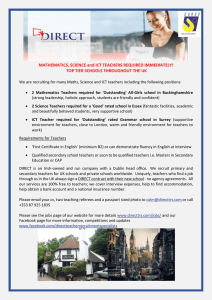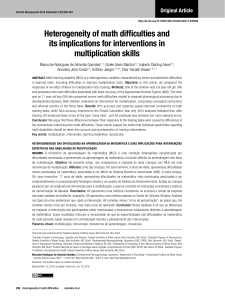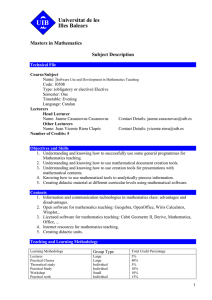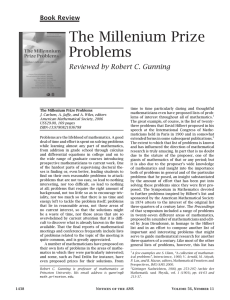Different possibilities to learn from the same task
Anuncio
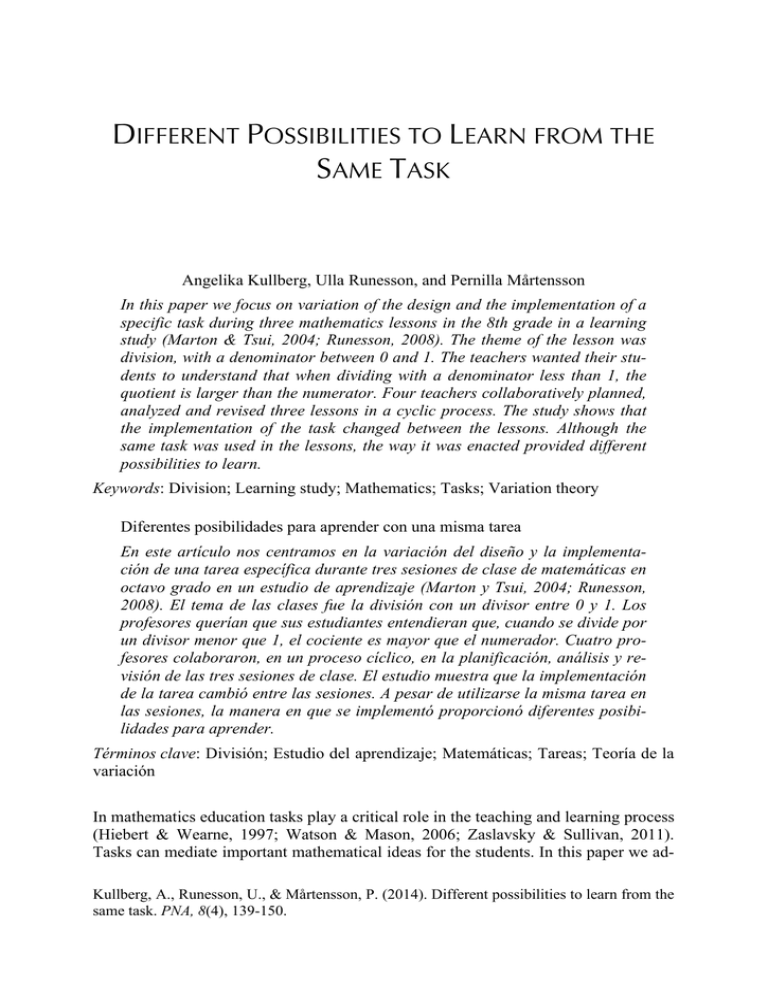
DIFFERENT POSSIBILITIES TO LEARN FROM THE SAME TASK Angelika Kullberg, Ulla Runesson, and Pernilla Mårtensson In this paper we focus on variation of the design and the implementation of a specific task during three mathematics lessons in the 8th grade in a learning study (Marton & Tsui, 2004; Runesson, 2008). The theme of the lesson was division, with a denominator between 0 and 1. The teachers wanted their students to understand that when dividing with a denominator less than 1, the quotient is larger than the numerator. Four teachers collaboratively planned, analyzed and revised three lessons in a cyclic process. The study shows that the implementation of the task changed between the lessons. Although the same task was used in the lessons, the way it was enacted provided different possibilities to learn. Keywords: Division; Learning study; Mathematics; Tasks; Variation theory Diferentes posibilidades para aprender con una misma tarea En este artículo nos centramos en la variación del diseño y la implementación de una tarea específica durante tres sesiones de clase de matemáticas en octavo grado en un estudio de aprendizaje (Marton y Tsui, 2004; Runesson, 2008). El tema de las clases fue la división con un divisor entre 0 y 1. Los profesores querían que sus estudiantes entendieran que, cuando se divide por un divisor menor que 1, el cociente es mayor que el numerador. Cuatro profesores colaboraron, en un proceso cíclico, en la planificación, análisis y revisión de las tres sesiones de clase. El estudio muestra que la implementación de la tarea cambió entre las sesiones. A pesar de utilizarse la misma tarea en las sesiones, la manera en que se implementó proporcionó diferentes posibilidades para aprender. Términos clave: División; Estudio del aprendizaje; Matemáticas; Tareas; Teoría de la variación In mathematics education tasks play a critical role in the teaching and learning process (Hiebert & Wearne, 1997; Watson & Mason, 2006; Zaslavsky & Sullivan, 2011). Tasks can mediate important mathematical ideas for the students. In this paper we adKullberg, A., Runesson, U., & Mårtensson, P. (2014). Different possibilities to learn from the same task. PNA, 8(4), 139-150. A. Kullberg, U. Runesson, and P. Mårtensson 140 dress the issue about the implementation of a task. What is made possible to learn from a specific task in different lessons? The task chosen is a sequence of items of non-contextualised arithmetic. Certainly, implementation of a task can be very different in different classrooms. What is possible for students to learn from a task may be affected by for instance, how the task is enacted, and students’ response and knowledge, but also by what mathematics is made explicit from the task. It has been suggested that tasks and teaching can be designed with variation in certain dimensions to enhance student learning (Al-Murani, 2007; Sun, 2010). Watson and Mason (2006) talk about using variation as a tool for designing tasks and the role of the teacher in this process: Constructing tasks that use variation and change optimally is a design project in which reflection about learner response leads to further refinement and precision of example choice and sequence…This process cannot be done by textbook authors working alone under tight publication deadlines but it can be done by teachers for themselves. (p. 100) In this paper, we describe such a design project: how one task was designed, enacted and successively refined by four teachers teaching in the 8th grade. The task was one of several tasks planned collaboratively by the teachers in an iterative process of planning, analysis and revision of a single lesson about division. This form of collaboration, called learning study, have shown that teachers become sensitive to their students’ learning and that the way they teach the topic changes due to the insights gained by student learning (Runesson, Kullberg, & Maunula, 2011). The aim of this paper is to discuss students’ possibilities to learn from the same task enacted in three different ways. How did the teachers implement the task and what was made possible to experience from the task by the learners? BACKGROUND OF THE STUDY The data used comes from a learning study about division conducted in Sweden. Learning study (Pang & Marton, 2005) is a version of the Japanese lesson study model (Fernández, 2005; Lewis, Perry, & Murata, 2006; Stigler & Hiebert, 1999) informed by a learning theory—variation theory (Marton, Runesson, & Tsui, 2004). The aim is to improve students’ learning by a careful and systematic inquiry into teaching and learning. The lessons are video recorded and students’ learning is mapped by analysing how they solve certain tasks before and after the lessons. The current study lasted one semester with several pre- and post-lesson meetings where the three mathematics teachers planned, analysed and revised the lesson plan. The teachers had about ten years of teaching experience and had volunteered to be part of the project. After planning the first lesson together, one of the teachers conducted the lesson in his/her class. The video-recorded lesson was analysed and, from what was observed in the lesson and analysis of how the students solved the tasks on the post-tests, changes for the next lesson were agreed about. After revising the lesson, the next teacher PNA 8(4) Different possibilities to learn from the same task 141 taught the lesson to his/her (new) class, and after a second revision, the third lesson was enacted by the third teacher. One of the researchers (third author of this paper) had a supportive role in the learning study; she took part in the discussions, recorded the lessons, conducted the tests and informed the teachers about the results. The teachers wanted their students to learn that in division, when the denominator is a decimal number between 0 and 1 (e.g., 24 / 0.8 = ? ) the quotient is larger than the numerator. Previous research shows that students’ overgeneralisations of rules valid in the domain of natural numbers lead to ideas like “multiplication always makes bigger and division always makes smaller” (e.g., 45 / 0.9 equals a quotient < 45 ) (Verschaffel, Greer, & De Corte, 2007, p. 569). The teachers were aware that the students often had this idea and planned the lesson to overcome this difficulty. Furthermore, they wanted their students to be able to solve divisions like 40 / 0.2 = without having to multiply by ten to get a whole number in the denominator (400 / 2 =) . They believed that this strategy would help the students to solve the problem, however, without understanding the underlying structure of division with decimals. The ideas of partitive division (e.g., 100 / 20 seen as 100 partitioned into 20 groups) and measurement division (how many groups of 20 go into 100) were introduced in all classes before the specific task was discussed (Greer, 1992). The task chosen to discuss in this paper is a sequence of items of non-contextualised arithmetic designed by the teachers (see Figure 1). The lesson as a whole consisted of several other tasks. ! ! 100+20=2000! !"" !" 100+4=400! !"" 100+2=200! !"" ! ! 100+1=100! !"" ! 100+0.5=50! !"" !.! 100+0.1=10! !"" !.! =5! =!25! =50! =100! =200" =1000! Figure 1. Items in the planned task ! Figure!1.!! ANALYSING! WHAT IS MADE POSSIBLE TO LEARN ! In order to analyse the implementation of the task from the point of view of what was made possible to learn, variation theory is used. An important idea within variation theory is that learning implies seeing something in a new way, by experiencing aspects that you have not experienced previously. To make it possible to notice these aspects it is necessary to experience variation (Dienes, 1960; Gibson & Gibson, 1955; Watson & Mason, 2006). The way we experience something, or how we learn to see PNA 8(4) A. Kullberg, U. Runesson, and P. Mårtensson 142 an object in a particular way, is a function of those aspects we notice or discern at the same time. If different individuals experience “the same thing” differently, they discern different aspects of the object in question. In order to understand or see a phenomenon or a situation in a particular way, one must discern all the critical aspects of the object in question simultaneously. Since an aspect is noticeable only if it varies against a background in invariance, the experience of variation is a necessary condition for learning something in a specific way (Marton & Pang, 2013). Four possible patterns of variation have been identified; contrast, generalisation, fusion, and separation (Marton et al., 2004). In previous studies, it has been demonstrated that variation theory can be used to analyze lessons from the point of view of the patterns of variation that are inherent in the lesson. It has also been found that this is reflected in what students actually learn (Kullberg, 2010; Marton & Pang, 2006). So, identifying the pattern of variation and invariance in the lesson implies to identify what is made possible to learn. Here we make use of the notion of contrast, since it was shown that the teachers frequently used this pattern of variation. Marton et al. (2004) point to the importance of experiencing contrast for learning: … in order to experience something a person must experience something else to compare it with. In order to understand what “three” is, for instance, a person must experience something that is not three: “two” or “four”, for example. This illustrates how a value (three, for instance) is experienced within a certain dimension of variation, which corresponds to an aspect (numeriosity or “manyness”). (p. 16) TEACHING DIVISION WITH A DENOMINATOR BETWEEN ZERO AND ONE As can be seen from Figure 1, there is a pattern of variation and invariance built into the task. We can see that the operations vary, since there are multiplication as well as division items. This variation makes it possible to discern differences between multiplication and division. Furthermore, the numbers within each column vary in a certain way, starting with larger to smaller numbers, keeping the number 100 invariant, making it possible to discern what happen to the answers when different numbers are multiplied to, or divided from 100. The numbers varied are positive integers with one or two digits and decimal numbers between zero and one with one decimal. The numbers were chosen to make it possible to experience differences between divisions with numbers less than 1. The same numbers are used in the two columns, except for in the answers to the items. With this design the teachers wanted to make it possible for the students to see what happened with the answer when one factor or the denominator changed. In the following, we show how the design of the task changed as a result of analysis of the revised lessons, the different ways they were implemented in the lessons, PNA 8(4) Different possibilities to learn from the same task 143 and, from that, draw conclusions about what was made possible to learn from the enacted task. DIFFERENCES IN IMPLEMENTATION OF THE TASK When we analyze how the same task was enacted in the three lessons, we can see that different aspects of division are made salient for the learner. Our suggestion is that seemingly the same task offered different learning possibilities for the students. Note that the task was successively written on the whiteboard by the teacher, one item at a time, starting with the first multiplication item, followed by other multiplication items, and thereafter the division items. The order in which the items were discussed in the lesson and what the teacher made explicit by visually pointing out is shown in Figures 2 to 4. Lesson 1 In Lesson 1, the task was enacted in a way that, from the theoretical framework taken, only made it possible for the learners to experience that multiplication can be used to “check” division. The teacher started the discussion about the task in Lesson 1 by asking for the answer to the item 100·20. The teacher continued with another item, multiplying one hundred with a smaller factor, 100·4, followed by two division items, 100 / 20 and 100 / 4 (Figure 2, see Section 1). The teacher pointed out that she used the same numbers in the multiplication and division items; however, nothing else was discussed. From the set of items it was visually possible to discern that multiplying with a smaller number give a smaller answer, and that dividing with a smaller number give a larger answer, but this was not discussed. The teacher continued with another set of items in multiplication (Section 2 in Figure 2) and thereafter division (Section 3 in Figure 2). Although this was the intention of the task, the items were solved with no specific discussion about what happened with divisions with numbers less than 1. After calculating all items, the teacher said “How can we connect these rules of arithmetic?” The class came to the conclusion that multiplying the quotient with the denominator, for example 20·5, will give the same answer as the numerator, 100 (see A in Figure 2). This relationship was pointed out by the teacher for all division items, namely that the answer to a division can be checked by a multiplication. PNA 8(4) A. Kullberg, U. Runesson, and! P. Mårtensson 144 ! A" 1" 100+20=2000! 100/20=5! 100+4=400! 2" 100+2=200! 100/4=25! 3" 100/2=50! 100+1=100! 100/1=100! 100+0.5=50! 100/0.5=200! 100+0.1=10! 100/0.1=1000! ! ! Figure!2.!! Figure 2. The enacted task in Lesson 11 As stated earlier, the enacted task only made it possible to experience a contrast be! tween the operations multiplication and division by using multiplication to check a ! the teacher said “the answers get bigger the further down division task. At one point, one gets” in the division column. However, we infer that this most likely was insuffi! intended. Even if the task !was designed with the intention cient for learning what was to make it possible for the students to discern that the quotient is larger than the numerator when dividing with a number less than 1, this was not focused upon. Instead, calculations were discussed (A in Figure 3), and no other relationships, patterns or numbers were discussed. Lesson 2 In contrast to Lesson 1, in the second lesson of the cycle, the designed task was handled in a way that made it possible for the learners to experience that when the denominator is a decimal number greater than 0, but less than 1, the quotient is larger than the numerator. Furthermore, it was made possible to experience that the product become smaller than the larger factor when multiplying by a number less than 1. In Lesson 2, the teacher started the discussion together with the students about the task by calculating the items (see Figure 3), starting with the multiplication items (Section 1) and continuing with the division items (Section 2). After doing the calculations, the teacher asked if the students could see any patterns between the items. The students identified two patterns. These were summarized by the teacher: “The smaller number multiplied with, the smaller the product and the smaller number divided by, the larger the quotient is.” 1 The items are grouped into sections (1 to 3) to show the sequence of how the items were presented on the whiteboard. The arrows (A in Figure 3) show what the teacher directed the students’ attention to, in this case the relationship between multiplication and division. If the quotient is multiplied with the denominator, the answer is the numerator. PNA 8(4) Different possibilities to learn from the same task !!!!!!!!!!!!!!!!!! 145 B" 1" 100+20=2000! 1 100+4=400! D" 2" !"" !" !"" ! 100+2=200! 100+1=100! !"" ! !"" ! 100+0.5=50! H" !"" !.! 100+0.1=10! ! ! !"" !.! =!5! =25! C" E" =50! =100! F" =200! G" =1000! ! " Figure 3. The enacted task in Lesson 22 Figure!3.!! The teacher explicitly pointed at the two columns (1 and 2), comparing the products and quotients with one another. Thereafter, the teacher ! ! pointed at the quotient and the numerator in 100 / 20 = 5 and 100 / 4 = 25 (see Figure 3) and said “here the quotient is a smaller number than the numerator, is it always like that?” This question made it possible for the students to experience a contrast between, on the one hand, division with numbers less than 1, and, on the other hand, division with numbers greater than or equal to 1. One student said that after zero there was a difference. Other students said that it was not the same for numbers less than 1, then the quotient became larger than the numerator. The different answers “zero” and “one” made a contrast as to where “it turned”. By comparing 0 and 1, the significant turning point was elucidated. The teacher drew a line under items with a denominator smaller than one (F in Figure 3) so the contrast became visible. Thereafter, the teacher first pointed to the denominators 1 and then to 0.5 and said “when the denominator is smaller than one, the quotient (pointed to the quotient) is larger than the numerator (pointed to the numerator) (F in Figure 3).” Next, the teacher made a contrast between the division item 100 / 0.5 and the multiplication item 100·0.5. She said “what happens with the multiplication item then?” The episode ended with the conclusion that the product, 50, is less than 100 (H in Figure 3). By comparing the items 100 / 0.5 and 100·0.5, it was possible to discern that the quotient became larger than 100, and the product smaller. The analysis demonstrates that, in Lesson 2, relationships between the quotient, denominator and numerator were made possible to learn by means of a pattern of var2 The items are grouped into sections (1 to 2) to show the sequence of how the items were presented on the whiteboard. The arrows (B-H in Figure 3) show what the teacher pointed to and hence directed the students’ attention to, in this case the relationship between the quotient, the numerator and the denominator, as well as the contrast between multiplication and division. PNA 8(4) A. Kullberg, U. Runesson, and P. Mårtensson 146 iation that elucidated how changes in the denominator affected the quotient and the numerator. Lesson 3 In the last lesson, the task was, in the same way as in Lesson 2, handled in a way that made it possible for the learners to experience that when dividing with a number less than 1, the quotient is larger than the numerator. However, more attention was paid to the items with the denominator < 1 . This was done by grouping the discussion into three sequences (see Figure 4). One difference was the sequence of the items (see Figure 4). The difference in sequence was that, in both multiplication and division, items with the number 0.1 were systematically compared with the items with number 0.5. This comparison made it possible to generalise both multiplication and division items with a denominator less than 1. In Lesson 3, initially the discussion was about the multiplication items in Section 1 (Figure 4), starting with the item 100·50 followed by 100·5, 100·1 and 100·0.5, followed by the items in Section 2—the divisions (2). After that, multiplication and division were discussed separately. The teachers said “look at the multiplication column first, do you see any pattern, anything that is the same or different?” The students said that the smaller number we calculate with the less zeros there are [in the product], and the smaller number there is [the product]. The teacher said “what are we used to get as an answer when we calculate a multiplication?” The students said that usually it is a larger number. The teacher continued, “Is it always like that? When do we not get a larger answer?” The students answered “After one”. The teacher pointed at the decimal number 0.5 and the product, and again at the product and 100 to show that the product in this case was smaller than 100 (I). The teacher asked if that was true for all decimals (less than 1), and introduced the item 100·0.1, as another example with multiplication with a number less than 1 (3). Thereafter, the teacher asked if the students could see patterns in the division column. The teacher said “what are we used to get as an answer when we calculate a division?” The students said that they were used to get a smaller answer when they divided. The teacher asked the students if it always is like that. The teacher said “do you see where it turns? Here we get a larger answer (quotient) [the teacher pointed at 100 / 0.5 = 200 ], when do we not get a larger number (quotient)? Is this true for all decimals? (J in Figure 3)” The teacher introduced another division item, 100 / 0.1 (J), to compare with 0.5. PNA 8(4) Different possibilities to learn from the same task 147 !!!!!!!!!!!!!!!!!! 1" 100+50=5000! 100+5=500! 2" !"" !" !"" ! 100+1=100! !"" ! 100+0.5=50! !"" I" 3" 100+0.1=10! !.! !"" !.! =!2! =20! =100! =200" J" =1000! 3 ! Figure 4. The enacted task in Lesson 3 Figure!4.!! In the end of the lesson, not in the discussion of the specific task analyzed here, division with two and three decimals were also introduced 100 / 0.02 = 500 ! 100 / 0.002 = 5000 ), as well as multiplication with two decimals ( 0.02·500=10 ). This contributed even further to make it possible for students to become aware of that, in a division with a denominator less than 1, the quotient becomes larger than the numerator by generalization to numbers with more decimals. DIFFERENT POSSIBILITIES TO LEARN FROM THE SAME TASK The case study reported is an example of a design project where teachers’ reflection on their teaching and the learners’ responses can lead to a refinement of the task design (Watson & Mason, 2006), but also to a greater accuracy and clarity about what to point out and make discernible to the learners. The task used in the lessons was designed by the teachers. The task consisted of multiplication and division items with both whole numbers and decimal numbers. The teachers decided a specific pattern of variation in the task to elicit aspects of division with a denominator less than 1. In the task, the same number (100) was divided or multiplied in a systematic way by a smaller number, so the learner would see easier how the quotient or the product changed (Al-Murani, 2007). This was the principle behind how the task was designed. We have shown that, when the (same) task was enacted in classrooms, the items were handled differently as regards to sequencing, as well as aspects of the content made explicit by the teacher, and aspects juxtaposed and contrasted. This was a result of the difference of that which was varied and kept invariant between the three lessons. We 3 The items are grouped into sections (1 to 3) to show the sequence of how the items were presented on the whiteboard. The arrows (I-J) show what the teacher pointed to and hence, directed the students’ attention to, in this case the relationship between the quotient, the numerator and the denominator, as well as the contrast between multiplication and division. PNA 8(4) A. Kullberg, U. Runesson, and P. Mårtensson 148 will suggest that these, rather subtle, differences affected what was made possible for the students to learn. So, what might be worth considering from this example is whether it is possible to say that the learners encountered the same task in the three different lessons or not. In one sense, it was the same task, but what the learners encountered in the lesson was different. Our interpretation is that, only in Lessons 2 and 3 the teachers’ intentions were brought out. As researchers and mathematics teachers, we ask ourselves if we sufficiently make use of the possibilities that are inherent in the task—regardless of who the designer is. A lesson is indeed interactive in nature. For instance, the teacher’s and the learners’ ways of questioning and responding can affect how the content is handled. So, a lesson might not turn out to be what we planned. Even if we think we have clearly brought out that which we intended to in the lesson or task, this may not be the case. We think that one thing that could be learned from this study is that, if students’ fail to learn, one reason could be that it was not made possible to learn this in the lesson. What we assume the task will mediate, might not be possible for the learners to see. As implications of this study, we suggest that teachers need to take an active role in how the task is enacted in the interaction with the students in the classroom. Since, we cannot take for granted that the learner discerns from the task what the teachers have in mind. In this study, the teacher in Lesson 1 wanted the students to see connections between, for instance, the quotient and the numerator; however, this was never discussed, pointed out, or made possible for students to become aware of. In Lessons 2 and 3, on the other hand, the teachers directed the students’ attention towards this. For instance, the teachers in Lessons 2 and 3 explicitly pointed out “were it turned”, when the quotient becomes larger than the numerator. We suggest that participation in a learning study gave the teachers time for reflection over the content and tasks used, and contributed to the teachers’ awareness of the implementation of the task. From the analysis of lessons, the teachers were able to identify what they needed to point out for the students in the lesson and also how to do it. ACKNOWLEDGEMENTS This research was funded by a grant from the Swedish National Research Council. REFERENCES Al-Murani, T. (2007). The deliberate use of variation to teach algebra: A realistic variation study. Unpublished doctoral dissertation, University of Oxford, United Kingdom. Dienes, Z. P. (1960). Building up mathematics. London, United Kingdom: Hutchinson Educational. PNA 8(4) Different possibilities to learn from the same task 149 Fernández, C. (2005). Lesson study: A means for elementary teachers to develop the knowledge of mathematics needed for reform-minded teaching? Mathematical Thinking and Learning, 7(4), 265-289. Gibson, J. J., & Gibson, E. J. (1955). Perceptual learning: Differentiation –or enrichment? Psychological Review, 62(1), 32-41. Greer, B. (1992). Multiplication and division as models of situations. In D. A. Grouws (Ed.), Handbook of research on mathematics teaching and learning (pp. 276-295). New York, NY: Macmillan. Hiebert, J., & Wearne, D. (1997). Instructional tasks, classroom discourse and student learning in second grade arithmetic. American Educational Research Journal, 30(2), 393-425. Kullberg, A. (2010). What is taught and what is learned. Professional insights gained and shared by teachers of mathematics. Göteborg, Sweden: Acta Universitatis Gothoburgensis. Lewis, C., Perry, R., & Murata, A. (2006). How should research contribute to instructional improvement? The case of lesson study. Educational Researcher, 35(3), 3-14. Marton, F., & Pang, M. F. (2006). On some necessary conditions of learning. The Journal of the Learning Sciences, 15(2), 193-220. Marton, F., & Pang, M. F. (2013). Meanings are acquired from experiencing differences against a background of sameness, rather than from experiencing sameness against a background of difference: Putting a conjecture to test by embedding it into a pedagogical tool. Frontline Learning Research, 1(1), 24-41. Marton, F., Runesson, U., & Tsui, A. B. (2004). The space of learning. In F. Marton & A. B. Tsui (Eds.), Classroom discourse and the space of learning (pp. 3-40). Mahwah, NJ: Erlbaum. Marton, F., & Tsui, A. B. (2004). Classroom discourse and the space of learning. Mahwah, NJ: Erlbaum. Pang, M. F., & Marton, F. (2005). Learning theory as teaching resource: Enhancing students, understanding of economics concepts. Instructional Science, 33, 159-191. Runesson, U. (2008). Learning to design for learning. The potential of learning study to enhance learning on two levels: Teacher’s and student’s learning. In T. Wood & P. Sullivan (Eds.), Knowledge and beliefs in mathematics and teaching development (pp. 153-172). Rotterdam, The Netherlands: Sense Publishers. Runesson, U., Kullberg, A., & Maunula, T. (2011). Sensitivity to student learning - a possible way to enhance teachers’ and students’ learning? In O. Zaslawski & P. Sullivan (Eds.), Constructing knowledge for teaching secondary mathematics (pp. 263-278). London, United Kingdom: Springer. Stigler, J., & Hiebert, J. (1999). The teaching gap: Best ideas from the world´s teachers for improving education in the classroom. New York, NY: The Free Press. PNA 8(4) A. Kullberg, U. Runesson, and P. Mårtensson 150 Sun, X. (2010). “Variation problems” and their roles in the topic of fraction division in Chinese mathematics textbook examples. Educational Studies in Mathematics, 76(1), 65-85. Watson, A., & Mason, J. (2006). Seeing exercise as a single mathematical object: Using variation to structure sense-making. Mathematical Teaching and Learning, 8(2), 91-111. Verschaffel, L., Greer, B., & De Corte, E. (2007). Whole number concepts and operations. In F. K. J. Lester (Ed.), Second handbook of research on mathematics teaching and learning (Vol. 1, pp. 557-628). Charlotte, NC: Information Age. Zaslavsky, O., & Sullivan, P. (Eds.). (2011). Constructing knowledge for teaching secondary mathematics. London, United Kingdom: Springer. This document was originally published as Kullberg, A., Runesson, U., & Mårtensson, P. (2013). The same task?-different learning possibilities. In C. Margolinas (Ed.), Task design in mathematics education. Proceedings of ICMI Study 22 (pp. 609-616). Oxford, United Kingdom: ICMI. Angelika Kullberg University of Gothenburg University of Jönköping [email protected] Ulla Runesson University of Jönköping University of the Witwatersrand [email protected] Pernilla Mårtensson University of Jönköping [email protected] Received: January 2014. Accepted: February 2014. Handle: http://hdl.handle.net/10481/31598 PNA 8(4)
